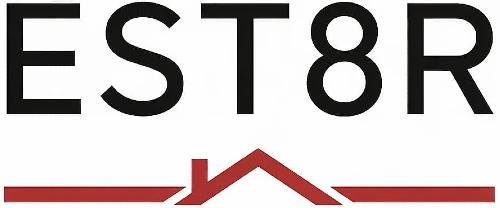In today’s ever-evolving real estate landscape, investors need to stay informed about emerging trends.
As we look ahead, the industry continues to experience shifts driven by technological advancements and changing economic conditions.
These developments present both challenges and opportunities, urging us to adapt and innovate to remain competitive.

The real estate sector is evolving, prompting us to explore critical trends that can significantly impact our investment strategies. Whether it’s leveraging new technologies or understanding market dynamics, staying abreast of these changes is essential for success.
By examining these key trends, we aim to provide insights that help navigate the complexities of the real estate market and enhance our investment approach.
1) Sustainable Building Practices

In recent years, the real estate industry has seen a significant shift towards sustainable building practices.
The focus is on creating structures that reduce environmental impact and enhance energy efficiency.
By incorporating eco-friendly materials and innovative design strategies, we aim to lower our carbon footprint and create healthier living environments.
These practices involve using materials that are sustainable, durable, and non-toxic.
Energy-efficient technologies, such as solar panels and smart thermostats, are increasingly integrated into new constructions.
These technologies help minimize energy consumption, resulting in lower utility costs for residents and building operators.
Water conservation is another essential component of sustainable building.
Implementing systems like rainwater harvesting and efficient plumbing fixtures can significantly reduce water usage.
As a community, we benefit from healthier ecosystems and reduced strain on local water resources.
In terms of financial benefits, sustainable building often reduces operating costs.
Initially, there might be higher upfront expenses, but the long-term savings in energy and water make it an economically wise choice.
Sustainable retrofits and smart design features can also increase property value and appeal to eco-conscious investors.
Socially, sustainable building practices can enhance community well-being.
Green spaces and natural daylight improve occupant health and productivity.
As a result, these developments contribute positively to the overall quality of life in the areas where we live and work.
Incorporating sustainable building practices is not only about meaningful environmental contributions.
We see it as a smart investment in the future of real estate.
By prioritizing sustainability, we ensure that our developments are resilient and adaptive to evolving environmental challenges.
2) Smart Home Technology

Smart home technology continues to influence the real estate industry in meaningful ways.
These technologies offer increased convenience, safety, and energy efficiency, making them highly attractive to buyers and investors.
As we integrate more smart devices into our properties, we see a growing demand for features like automated lighting, smart thermostats, and voice-activated assistants.
These innovations not only enhance daily living but also contribute to the property’s value.
Potential buyers often prefer homes equipped with advanced technology, recognizing the long-term benefits.
The appeal of smart homes extends to energy management.
Technology like smart meters and energy-efficient appliances reduces utility costs.
This results in lower monthly expenses and a smaller environmental footprint, which are significant attractions for environmentally-conscious buyers.
Security is another strong point in favor of smart home systems.
Smart locks, cameras, and alarm systems offer reliable protection.
They provide homeowners with peace of mind and an additional selling point when marketing a property.
We also observe how properties with smart home technology have shorter listing times.
The convenience and modern appeal of such homes attract immediate interest.
It streamlines the real estate process, benefiting both sellers and buyers.
The adoption of smart home technology in real estate isn’t just a trend; it’s becoming a standard.
As the technology advances, we anticipate further integration of these features into residential and commercial properties, enhancing the overall real estate investing landscape.
3) Fractional Ownership
Fractional ownership is transforming the real estate investing landscape by allowing multiple investors to share ownership of a single property.
This approach lowers the capital needed to enter the market, making it more accessible for a broader range of investors.
By pooling resources, we can acquire shares in high-quality properties that might otherwise be beyond our individual reach.
One of the significant advantages of fractional ownership is the potential for risk mitigation.
Since our investments are spread across various properties, a poor performance in one doesn’t drastically impact our entire portfolio.
This diversification can lead to more stable and predictable returns.
Technological advancements play a key role in this trend.
Digital platforms are making it easier for us to participate in fractional investing, enabling us to access opportunities across different regions, including international markets.
This allows us to capitalize on global real estate trends and benefits.
When investing in fractional ownership, we need to consider factors such as alignment of interest, asset profile, and the experience offered by the real estate platforms.
These criteria can help us evaluate different investment options more effectively and select those that align with our investment goals.
Staying informed about market trends is crucial for successful fractional ownership.
By being aware of economic factors and changes in the real estate sector, we can make informed decisions about where to direct our investments.
This proactive approach can enhance our chances of achieving long-term success in the evolving real estate landscape.
4) Real Estate Crowdfunding
Real estate crowdfunding has emerged as a significant trend in real estate investing, opening new avenues for both seasoned investors and newcomers.
By pooling funds from various investors, we can access opportunities that were traditionally reserved for those with substantial capital.
This innovative investment strategy allows us to diversify our portfolios more effectively.
By investing smaller amounts across multiple properties, we can spread risk and potentially increase returns.
The flexibility to invest in different asset classes also enhances our ability to adapt to market changes.
The rapid growth of real estate crowdfunding platforms reflects a broader democratization of investment opportunities.
As technology advances, these platforms offer us greater transparency and lower barriers to entry.
This accessibility is likely to attract a wider range of investors, further fueling growth.
The projected growth of the real estate crowdfunding market is impressive.
With an estimated USD 10.8 billion in value and expectations to reach USD 250 billion by 2030, the potential for expansion is significant.
This expected growth highlights the increasing popularity and acceptance of crowdfunding as a viable investment option.
Regulatory frameworks and investor protections continue to evolve, enhancing our confidence in these platforms.
Keeping abreast of these changes is essential for navigating the landscape safely.
We must remain vigilant about the specifics of each offering and perform thorough due diligence before making investment decisions.
By embracing real estate crowdfunding, we grant ourselves the opportunity to explore diverse avenues and participate in a dynamic market.
With careful consideration and strategic planning, this trend offers considerable promise for our investment portfolios.
5) Co-living Spaces

Co-living spaces represent a dynamic shift in the real estate landscape that caters particularly to urban environments.
These spaces emphasize shared living arrangements where residents can benefit from both private and communal areas.
As our cities grow more crowded, co-living offers an efficient alternative that optimizes available space and resources.
One of the key advantages of co-living is affordability.
By sharing living costs and utilizing common amenities, residents can save significantly compared to traditional housing options.
This cost-effective model appeals to young professionals, digital nomads, and students who seek flexible living arrangements without long-term commitments.
Community is at the heart of co-living spaces.
Designed to foster social connections, these environments encourage interaction and collaboration among residents.
This emphasis on building a sense of belonging is particularly appealing in today’s fast-paced urban settings, where people often long for personal connections.
Investors are increasingly recognizing co-living as a promising asset class in the real estate market.
With rising demand for flexible and affordable housing options, co-living developments present new opportunities for long-term growth.
As such, investing in co-living properties can serve as a diverse addition to our real estate portfolios.
Emerging digital tools and platforms are facilitating the growth of co-living spaces.
Technologies like smart home systems and online management apps enhance the living experience, making co-living more efficient and appealing.
This tech-driven approach helps streamline operations and attract tech-savvy residents looking for modern housing solutions.
Co-living is set to play a significant role in the evolution of urban living, reshaping how we approach residential spaces.
As cities continue to evolve and adapt to changing demographics, co-living will likely remain a focal point for innovative real estate strategies.
6) Blockchain for Transactions

In the real estate sector, blockchain technology is revolutionizing how transactions are completed.
This technology provides a higher level of automation, enhancing both the speed and security of transactions.
By utilizing blockchain, we can significantly mitigate the risk of fraud, a crucial factor in real estate dealings.
Blockchain platforms offer a streamlined process, reducing the traditionally lengthy closing periods.
Automated processes enabled by blockchain can replace many manual steps, leading to increased efficiency.
This dramatically shortens the time it takes to finalize real estate deals.
Our industry is witnessing a transformation where transparency is greatly enhanced.
Blockchain enables the tracking of transactions in a transparent manner, making all parties privy to the status and history of a transaction.
This transparency fosters trust and confidence among real estate stakeholders.
The decentralization feature of blockchain plays a pivotal role in real estate by removing intermediaries.
This reduces transaction costs and allows more direct interactions between buyers and sellers.
In doing so, we gain a more efficient market environment.
Moreover, blockchain technology opens new doors for innovative investment models.
By breaking down properties into digital tokens, blockchain facilitates fractional ownership, making real estate investment more accessible.
This can potentially diversify investment opportunities.
Blockchain is not without challenges, but its potential benefits in real estate transactions are substantial.
The technology promises to reshape our approach, creating a more efficient, secure, and transparent ecosystem for real estate transactions.
The Role of Technology in Real Estate

In recent years, technology has become an integral part of the real estate landscape, redefining how professionals operate and enhancing client experiences.
The integration of artificial intelligence and immersive tools has revolutionized property transactions and client interactions.
Artificial Intelligence and Big Data
Artificial intelligence (AI) and big data are transforming real estate by improving decision-making processes and offering valuable insights into market trends.
We utilize AI to personalize recommendations and streamline operations, resulting in more efficient management of properties.
Through big data, we analyze vast datasets to predict property values and identify investment opportunities.
For investors, this means assessing potential risks and returns with greater accuracy.
AI tools help us understand consumer behavior and preferences, allowing for targeted marketing strategies.
By leveraging big data, we gain a competitive edge, unlocking patterns and trends that were previously inaccessible.
Virtual and Augmented Reality in Property Viewing
Virtual and augmented reality (VR and AR) are reshaping property viewing experiences.
They allow clients to explore properties without being physically present.
We offer virtual tours that provide a detailed, immersive view of spaces, helping clients make informed decisions.
With AR, clients can visualize modifications and furnishings within a property.
This technology saves time and resources, reducing the need for multiple site visits.
Real estate agents use VR to showcase properties worldwide, broadening our market reach.
By embracing these tools, we enhance client interactions.
We deliver engaging and convenient ways to experience real estate.
Changing Demographics and Their Impact

We explore how shifting population trends influence real estate investing.
Factors such as millennial preferences and the needs of an aging population significantly shape market dynamics.
Millennial Preferences in Housing
Millennials are increasingly influencing housing markets.
This generation values flexibility and sustainability, often prioritizing locations with access to public transportation, job opportunities, and vibrant communities.
Properties that offer smart home technology, energy-efficient designs, and community amenities tend to capture their interest.
In urban areas, demand for multifamily homes and rental properties remains strong.
As work-from-home arrangements become more common, we’re seeing a rise in interest for homes with dedicated office spaces and larger living areas.
Meeting these preferences requires adapting our strategies to position ourselves as appealing to this tech-savvy demographic.
Aging Population and Senior Housing
The aging population presents unique opportunities and challenges.
As the baby boomer generation enters retirement, there’s a growing demand for senior-friendly housing solutions.
Properties that offer accessibility features, such as single-story layouts, step-free entrances, and accessible bathrooms, are increasingly sought after.
Many older adults seek communities providing healthcare services, recreational activities, and social connections.
Incorporating these elements into senior housing developments can enhance their marketability.
Furthermore, investing in assisted living facilities or 55+ communities may yield promising returns, as the need for such accommodations is likely to rise with an aging demographic.
Frequently Asked Questions

In this section, we address popular queries regarding trends in real estate investing.
Our focus is on technological advancements, sustainability, changing demographics, and shifting work environments, all crucial in shaping current and future investment landscapes.
What are the emerging trends influencing commercial real estate investments in 2024?
Emerging trends include the increasing demand for sustainable building practices and the integration of smart technology within commercial properties.
We also see growth in fractional ownership models, which allow investors to partake in commercial real estate with lower capital outlays.
How might new technological advances impact the future of real estate investing?
Technological advances such as smart home features and real estate crowdfunding platforms are transforming how we approach investments.
These innovations improve property management efficiency and expand access to investment opportunities for a broader range of individuals.
In what ways is sustainability driving change in real estate investment strategies?
Increased emphasis on sustainability is reshaping strategies as more investors seek eco-friendly and energy-efficient properties.
Compliance with sustainability regulations and the push for green certifications are becoming priorities, enhancing long-term asset value and appeal to environmentally conscious tenants.
What demographic shifts are affecting the real estate market and investor decisions?
Urbanization and an aging population are significant demographic shifts affecting investor decisions.
We observe heightened interest in co-living spaces among younger demographics and a demand for senior housing solutions, influencing the types of developments investors prioritize.
How are economic and geopolitical factors shaping the real estate investment landscape?
Economic uncertainties and geopolitical tensions can influence real estate values and investor confidence.
Interest rate fluctuations, trade policies, and global market stability play crucial roles in shaping investment strategies and risk assessments in various regions.
What investment opportunities are arising from the evolution of the workplace and remote work trends?
The rise of remote work has led to more flexible office space solutions and an increased demand for properties in suburban areas.
We notice a shift towards offering co-working spaces and adaptive lease models.
These changes align with new workplace dynamics and investor interests.

